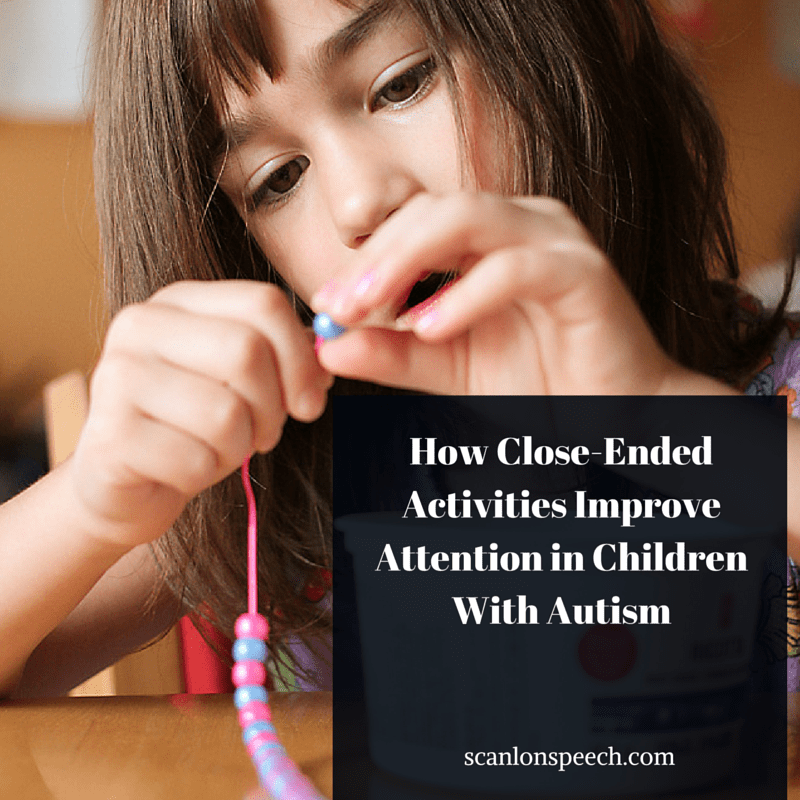Sign Up For Our E-Blast To Receive Information on our Books, Speech Therapy materials and our latest freebies!
How Close-Ended Activities Improve Attention in Children with Autism
“Jason? Please sit down. Jason…? I need you to…Jason, please sit down.”
Photo Credit: friesen4
How Close-Ended Activities Can Improve Attention in Children with Autism
According to Autism Speaks, a well-known American autism advocacy organization, many medical and behavioral issues often co-exist with autism spectrum disorder (ASD). “These co-morbid conditions include anxiety, depression, attention deficit/hyperactivity disorder (ADHD), gastrointestinal (GI) problems, sleep disturbances and epilepsy.”
The purpose of this post is to share one strategy to assist you in improving the attention of a young child with ASD. If you’re looking for more strategies please read – 5 Ways to Increase Attention in Young Children with Autism.
Here’s my tip –
Make sure the activity or play routine has a definitive end.
What does it mean to have a definitive end to a play routine?
It means that the child can either see, hear, feel or somehow sense the play routine will end.
When all the pieces of the puzzle are in, Ben will realize that the puzzle is complete.
When the 10 beads are threaded, our bracelet is made.
When we sing, “We all fall down”, the nursery rhyme Ring around the Rosie is finished.
Perhaps we can think of the play routine as being a task.Many children feel a sense of pride when they successfully complete a task. Since they had such a good time, they want to repeat the experience.
When people know what to expect their attention and task performance improve. Children with ASD are no different. Many need to know what to expect and when something will end. Yet, how often do we forget to tell our children what’s expected of them?
Imagine going to work and not knowing what you were supposed to do? Or, being asked to participate in a tedious assignment, but not knowing when it would end? Wouldn’t your attention quickly wane?
When a play routine is close-ended the child can anticipate the flow. This increases compliance, attention, and even promotes relaxation.
Some children need shorter routines to stay focused while others with stronger attention skills can participate in longer more complex, flexible play routines.
Before you start thinking, “Oh but aren’t close-ended toys too restrictive? Won’t they limit my child’s problem solving skills? Won’t they prevent my child’s imagination from blossoming?
I’m not suggesting that all play routines be close-ended. There are many cognitive and emotional benefits to participating in open-ended play routines (of course!) but exploring those benefits and the situations for when they are best is not the point of THIS post. Furthermore, selecting an appropriate toy, game, or activity requires skill and insight. If you have a child or know a child who has a short attention span and struggles to engage in meaningful open-ended play (e.g. playing with dolls, blocks, or cars) take a step back and start with something they can do. This will help grow his or her attention span. Once attention has improved, you’re child will be ready to embrace and enjoy those longer, more advanced play routines.
Language learning blooms and blossoms with multiple attempts and repeated experiences.
Always contemplate the needs and abilities of the child and remember to have fun.
For further reading, please see:
7 Close Ended Games, Activities and Toys to Build Attention in Preschoolers
Kimberly Scanlon, M.A. CCC-SLP is a speech language pathologist, an author and a mother. As the owner of Scanlon Speech Therapy, LLC, a unique boutique practice in Bergen County, Kimberly embraces individuality and treats the whole person. Her goal is to spread compassion, hope, and some speech, language and literacy tips one moment, one person at a time. Her first book, My Toddler Talks: Strategies and Activities to Promote Your Child’s Language Development and her second book, Learning to Read is a Ball
are available for purchase at online at Amazon and Barnes and Noble.

